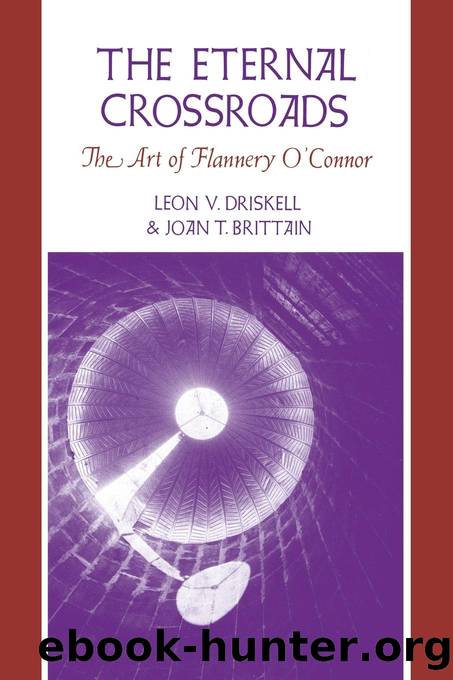The Eternal Crossroads by Unknown

Author:Unknown
Language: eng
Format: epub
Publisher: University Press of Kentucky
Published: 2021-08-15T00:00:00+00:00
CHAPTER SIX
The Posthumous Collection
From the Garden of Eden to Judgment Day
HAVING ESTABLISHED the nature of Miss OâConnorâs frame for Everything That Rises Must Converge, we must yet remark her thematic development in the remaining stories through the accumulation of significant symbols. Spectacles, for instance, recur in this collection as one of Miss OâConnorâs means of establishing the difference between spiritual vision and physical sight. The Negro actorâs hornrimmed glasses oppose the empty frames of Tannerâs carved spectacles; the hornrims are a costume detail, but the carved spectacles lead to a revelation of common humanity. In the title story Miss OâConnor emphasizes the unmoored eye of Julianâs dying mother; she had used almost precisely the same image in dramatizing Mrs. Shortleyâs death in âThe Displaced Person.â The collection also relies heavily on the recurrent image of the revelatory dark line of trees and on the passage past the dragon. As the ultimate convergence, the cessation of time in its ordinary sense, death marks the successful passing of the dragon.
In each story a self-sufficient character meets his âcomeuppance,â but in each story the action is presented in such a way as to permit hope of redemption or of a redemptive and âpurifying terror.â The doctrinal progression in the nine stories of Everything That Rises Must Converge is perhaps more pronounced than in A Good Man Is Hard to Find, for the white woman who dies in the title story experiences a regression at the time of her death, while at the end old Tanner has a vision of his resurrection. In both instances the end result for the chief characters is death, or, as Teilhard might say, diminishment. Tanner makes considerably more of his death than does the nameless woman of the title story, but this does not lessen the anagogical significance of her death.
âEverything That Rises Must Convergeâ first appeared in New World Writing in 1961. âJudgement Day,â a revision of âThe Geraniumâ (Accent, 1946), is one of Miss OâConnorâs earliest stories. Its revisions further support the idea of her thematic consistency.
In the title story Julian, a young, unmarried man living with his mother, joyfully witnesses her humiliation on a bus as he accompanies her to her reducing lesson at the âY.â The unsuccessful son, spiritual kin to the protagonists in âThe Partridge Festivalâ and âThe Enduring Chill,â longs vaguely to be a writer; he thinks that he has accepted the new social order of legislated equality and attempts to fraternize with the well-dressed Negroes on the bus. (He is snobbish and was horrified on one occasion to discover that a Negro whose friendship he had cultivated was a bookie.) Julianâs annoyance with his mother is based on her ignorance of her own situation: she claims that she âknows who she is,â but her sense of identity is apparently dependent upon a âgood familyâ and former affluence. She has shared with Julian her memories of the old family home, and he longs desperately for the graceful life it represents.
Part of the
Download
This site does not store any files on its server. We only index and link to content provided by other sites. Please contact the content providers to delete copyright contents if any and email us, we'll remove relevant links or contents immediately.
The Lost Art of Listening by Michael P. Nichols(7412)
Why I Am Not A Calvinist by Dr. Peter S. Ruckman(4109)
The Rosicrucians by Christopher McIntosh(3470)
Wicca: a guide for the solitary practitioner by Scott Cunningham(3128)
Signature in the Cell: DNA and the Evidence for Intelligent Design by Stephen C. Meyer(3076)
Real Sex by Lauren F. Winner(2970)
The Holy Spirit by Billy Graham(2896)
To Light a Sacred Flame by Silver RavenWolf(2770)
The End of Faith by Sam Harris(2692)
The Gnostic Gospels by Pagels Elaine(2474)
Waking Up by Sam Harris(2396)
Nine Parts of Desire by Geraldine Brooks(2330)
Jesus by Paul Johnson(2314)
Devil, The by Almond Philip C(2285)
The God delusion by Richard Dawkins(2267)
Heavens on Earth by Michael Shermer(2243)
Kundalini by Gopi Krishna(2138)
Chosen by God by R. C. Sproul(2125)
The Nature of Consciousness by Rupert Spira(2049)
